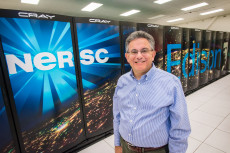Jeff Broughton Looks Back, and Prepares for the Next Thing
June 22, 2022
By Elizabeth Ball
Contact: cscomms@lbl.gov

Jeff Broughton stands by the Edison supercomputer that he helped bring to NERSC, one of his proudest accomplishments during a long career.
Day in and day out, the National Energy Research Scientific Computing Center (NERSC) at Lawrence Berkeley National Laboratory provides powerful and reliable service to thousands of users worldwide, supporting a broad range of cutting-edge science research for the present and the future. And since 2009, the vision for keeping all that work going — from the 30,000-foot view to the nitty-gritty details — has fallen on the shoulders of Deputy for Operations Jeff Broughton, who retires this month after 13 years at NERSC.
“It’s always been interesting and challenging,” said Broughton of his commitment to keeping NERSC up and running and solving problems to support scientific progress. He cited the ongoing task of keeping the many parts of a large computing setup humming along — “on the order of millions of processors, multiple petabytes of storage, a lot of ‘moving’ parts” — as well as the challenge of leaping into the future with new, cutting-edge machines every four to five years. And as performance benchmarks get higher, he has worked continually to reduce NERSC’s environmental footprint, making it truly a facility for the future.
“More than anything else, although we’re working in terms of supporting and operating these large computer systems and we’re not directly doing science, other than a little computer science, the opportunity to help science get done really makes the work worthwhile,” said Broughton of the enduring appeal and ongoing challenge of his work.
After graduating from the Massachusetts Institute of Technology, Broughton was recruited to California by a friend and began his career working in the special projects group in the physics department at Lawrence Livermore National Laboratory, where he worked on the design of the S-1 computer system. Later, he movedto the private sector, where he was awarded five system architecture patents and played a key role in developing a massively parallel logic simulation architecture for Sun Microsystems. As founder and VP of Engineering at PathScale, an HPC start-up, he won the HPCWire "Most Significant New HPC Software Product for 2005" for his work on a commercially viable compiler based on open-source technology. In 2009, Broughton came to NERSC as Systems Department Head, and was later promoted to Deputy for Operations.
Broughton is proud of many moments and accomplishments from his time at NERSC, but cites the acquisition of the Edison system and the design and construction of Shyh Wang Hall, a state-of-the-art facility that will house NERSC for many years to come, as some of his favorite contributions.
Another proud moment was when NERSC moved from its previous Oakland location to the completed Wang Hall with an outage to users of just three hours. ”It was an enormous team effort at NERSC,” said Broughton. “There was a lot of careful planning and coordination among a whole number of different groups, each of which worked really hard to accomplish their part of the job. And although I know my management was quite nervous about whether it would be done on time, we ended up pulling it off. There was no magic to it — it was a lot of really hard work.”
Director of NERSC Sudip Dosanjh echoed Broughton’s thoughts: "Jeff has been very dedicated to NERSC’s mission and has been a strong supporter of staff that report to him,” said Dosanjh. “He oversaw the deployment of Edison, which was a highly popular system among our users. He played a key role in the successful completion of the Wang Hall project and NERSC’s move from the Oakland Scientific Facility. As NERSC Deputy for Operations, he helped ensure that our facility was always up and running and responded to numerous weather, air quality, and power issues.”
Data department head Katie Antypas agreed, citing Broughton’s extensive knowledge and experience. “Jeff has been a tremendous leader for NERSC, “ said Antypas. “His deep understanding of Lab facilities and operations, and his extensive networks there, have been invaluable as NERSC has completed increasingly complex facility upgrades. In addition, he has been an amazing resource for me personally on obscure Lab fiscal, user agreement, and technology transfer policies. He will be missed!”
After his retirement, Broughton intends to spend time traveling and honing his skills as a woodworker, turning bowls and other items.
Having spent time at multiple national labs and in the private sector, and with the benefit of a long career behind him, Broughton is clear about the benefits of working in the national laboratory system from either a scientific or an operations perspective.
“I think what’s unique about it is you get really hard problems to solve, but then you get the resources to attack them,” he said. “I don’t just mean resources in terms of funding, although that’s one part of it. But the intellectual resources across all the wide disciplines that is available to help bring to bear on a project I think is unmatched.”
About NERSC and Berkeley Lab
The National Energy Research Scientific Computing Center (NERSC) is a U.S. Department of Energy Office of Science User Facility that serves as the primary high performance computing center for scientific research sponsored by the Office of Science. Located at Lawrence Berkeley National Laboratory, NERSC serves almost 10,000 scientists at national laboratories and universities researching a wide range of problems in climate, fusion energy, materials science, physics, chemistry, computational biology, and other disciplines. Berkeley Lab is a DOE national laboratory located in Berkeley, California. It conducts unclassified scientific research and is managed by the University of California for the U.S. Department of Energy. »Learn more about computing sciences at Berkeley Lab.







